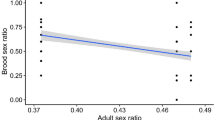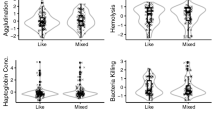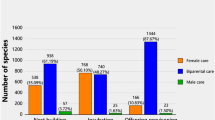Abstract
By engaging in extra-pair matings, the most successful males in some bird species can father twice as many young as are present in their own nest1,2. Here we describe a female parallel in goldeneye ducks (Bucephala clangula), whereby some females can double their reproductive output by combining brood parasitism with normal nesting. This huge reproductive advantage should create strong selection for parasitic tactics.
This is a preview of subscription content, access via your institution
Access options
Subscribe to this journal
Receive 51 print issues and online access
$199.00 per year
only $3.90 per issue
Buy this article
- Purchase on Springer Link
- Instant access to full article PDF
Prices may be subject to local taxes which are calculated during checkout

Similar content being viewed by others
References
Kempenaers, B. et al. Nature 357, 494–496 (1992).
Sheldon, B. C. & Ellegren, H. Anim. Behav. 57, 285–298 (1999).
Andersson, M. & Åhlund, M. Ecology 82, 1433–1442 (2001).
Andersson, M. & Åhlund, M. Proc. Natl Acad. Sci. USA 97, 13188–13193 (2000).
Eadie, J. M., Kehoe, F. P. & Nudds, T. N. Can. J. Zool. 66, 1709–1721 (1988).
Eadie, J. M. Alternative reproductive tactics in a precocial bird: the ecology and evolution of brood parasitism in goldeneyes. Thesis, Univ. British Columbia (1989).
Sorenson, M. D. Anim. Behav. 42, 771–796 (1991).
Lyon, B. C. Anim. Behav. 46, 911–928 (1993).
Brown, C. R. & Brown, M. B. Behav. Ecol. 9, 158–171 (1998).
McRae, S. B. Behav. Ecol. 9, 93–100 (1998).
Author information
Authors and Affiliations
Corresponding author
Rights and permissions
About this article
Cite this article
Åhlund, M., Andersson, M. Female ducks can double their reproduction. Nature 414, 600–601 (2001). https://doi.org/10.1038/414600b
Issue Date:
DOI: https://doi.org/10.1038/414600b
This article is cited by
-
Reproductive and brood-rearing strategies in Alchisme grossa (Hemiptera: Membracidae): genetic analyses of kinship relationships
Insectes Sociaux (2020)
-
Conspecific brood parasitism in an upland-nesting bird: cues parasites use to select a nest
Behavioral Ecology and Sociobiology (2020)
-
Social parasitism as an alternative reproductive tactic in a cooperatively breeding cuckoo
Nature (2019)
-
When cooperators cheat
Nature (2019)
-
Kin-biased conspecific brood parasitism in a native Mandarin duck population
Journal of Ornithology (2016)
Comments
By submitting a comment you agree to abide by our Terms and Community Guidelines. If you find something abusive or that does not comply with our terms or guidelines please flag it as inappropriate.



